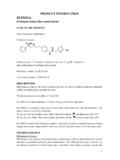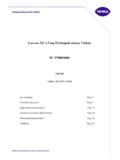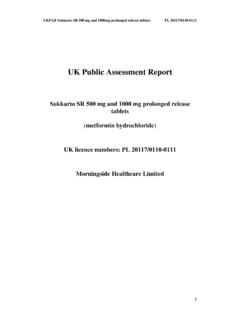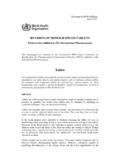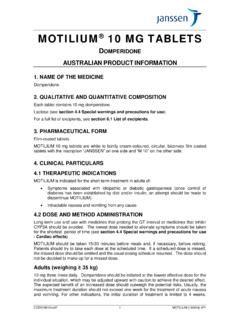Transcription of DATA SHEET DILZEM - Medsafe
1 1 | Page New Zealand data SHEET 1. PRODUCT NAME DILZEM 30 mg film coated tablets DILZEM 60 mg film coated tablets 2. QUALITATIVE AND QUANTITATIVE COMPOSITION Diltiazem hydrochloride 30 mg Diltiazem hydrochloride 60 mg Excipient(s) with known effect: DILZEM tablets contain lactose. For the full list of excipients, see section 3. PHARMACEUTICAL FORM DILZEM 30 mg tablet: a white, circular, film - coated , biconvex tablet of approximately 6mm diameter embossed "D" one side. DILZEM 60 mg tablet: a white capsule shaped, film - coated tablet, 10mm in length and 5mm wide; with a breakline and DL60 engraved on one face.
2 4. CLINICAL PARTICULARS Therapeutic indications Angina pectoris due to coronary artery spasm and chronic stable angina. Dose and method of administration Dose Adults Initially 30 mg three to four times daily increasing to 240 mg daily in divided doses. The maximum recommended dose is 360 mg daily. Special populations Elderly population Pharmacokinetics of diltiazem in elderly patients has not been fully elucidated. Preliminary results in elderly patients (over 65 years old) suggest that a lower dosage might be required in this age group. 2 | Page Hepatic and renal impairment There are few available data concerning dosage requirements in patients with impaired renal or hepatic function.
3 DILZEM should be used with caution in patients with hepatic or renal impairment. If diltiazem must be used in these patients, the dosage should be carefully and gradually adjusted depending on patient tolerability and responses. Concomitant use with other cardiovascular agents Sublingual glyceryl trinitrate may be taken as required to abort acute anginal attacks during DILZEM therapy. DILZEM may be safely co-administered with short- and long-acting nitrates. Paediatric population Safety and efficacy in children aged has not been established. Therefore, diltiazem is not recommended for use in children. Method of Administration Oral administration.
4 Contraindications Patients with sick-sinus syndrome except in the presence of a functioning ventricular pace-maker. Patients with second or third degree AV block. Patients with hypotension (< 90mmHg systolic). Severe congestive heart failure or bradycardia. Idiosyncrasy to diltiazem. Pregnancy. Special warnings and precautions for use Cardiac Conduction: Caution is required in cases of first degree AV block. Diltiazem prolongs AV node refractory periods but not sinus node recovery times (except in sick sinus syndrome). This may result in slowing of heart rate, prolongation of the PR interval or even second or third degree AV block.
5 Concomitant use of diltiazem with beta-blockers or digitalis may result in additive effects on cardiac conduction. Congestive Heart Failure: Caution must be exercised in patients with congestive heart failure. Hypotension: Arteriolar dilation produced by diltiazem administration may occasionally give rise to symptomatic hypotension. Acute Hepatic Injury: In rare instances, patients receiving diltiazem have exhibited reversible acute hepatic injury as evidenced by moderate to extreme elevations of liver enzymes. 3 | Page Respiratory Events: The use of diltiazem may induce bronchospasm, including asthma aggravation, especially in patients with pre-existing bronchial hyper-reactivity.
6 Cases have also been reported after dose increase. Patients should be monitored for signs and symptoms of respiratory impairment during diltiazem therapy. Concomitant Administration with Beta-Blockers: Diltiazem may cause marked prolongation of atrioventricular conduction in a small number of patients, and caution is advised if combination therapy is considered due to the risk of bradycardia. Such a combination should not be used in patients with depressed left ventricular function and conduction system disease. Abrupt Withdrawal: The sudden withdrawal of diltiazem has been associated with severe angina.
7 Use in Diabetics: Diltiazem influences insulin secretion and peripheral action as a result of inhibition of calcium influx into cells so caution is required if diltiazem is considered for use in diabetic patients. Use with Amiodarone: Caution is required if consideration is being given to the use of diltiazem and amiodarone in combination especially in the presence of underlying dysfunction of the sinus node such as bradycardia, sick sinus syndrome or partial AV block. Concomitant Use with Digoxin: The combination of diltiazem with digitalis may give rise to additive effects in prolonging AV conduction.
8 General: Diltiazem is extensively metabolised by the liver, metabolites being eliminated by the kidneys and in bile. It should be used with caution & in reduced dosage in patients with impaired renal or hepatic function. Liver function tests should be monitored during prolonged use as very rare transaminase elevations have been noted. Interaction with other medicines and other forms of interaction The combination of diltiazem with beta-blockers may produce a positive clinical response in patients with angina pectoris. Care is required, however, since AV conduction may be prolonged leading to serious deleterious effects (See Warnings and Precautions).
9 Diltiazem is known to modify digoxin pharmacokinetics in healthy subjects, and in patients with cardiac insufficiency or chronic atrial fibrillation. These modifications involved: an increase in plasma digoxin concentration of 24-70%, a decrease in mean renal digoxin clearance from mL/min to mL/min, and an increase in the mean digoxin elimination half-life from h to h. Concurrent administration of diltiazem with cimetidine results in an increase in both diltiazem and desacetyl diltiazem plasma levels. Concomitant administration of diltiazem with diazepam causes a significant decrease, averaging between 20-30%, in diltiazem plasma levels.
10 The 4 | Page combination of diltiazem with amiodarone may have additive adverse effects on sinus node function and myocardial contractility. Chronic administration of diltiazem to patients on cyclosporin-A will result in increased trough levels of cyclosporin-A. Diltiazem HCl should not be administered with carbamazepine as two well-documented cases have been reported where combination resulted in neurotoxicity. A single case has been reported of cardiac arrhythmia involving sinus arrest and impaired AV conduction after administration of enflurane and diltiazem together. A single case has been reported of decreased insulin effect after combination treatment of insulin and diltiazem although the mechanism was not established.










